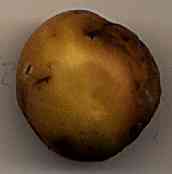
Bark, foliage and immature fruits on a tree in the Sydney Botanical Garden [C.J. Earle].

Fruit, 19 mm diameter, from a tree in the Los Angeles Arboretum [C.J. Earle].
Common Names
Outeniqua yellowwood (2).Taxonomic notes
Syn: Podocarpus falcatus (Thunb.) R.Br. ex Mirb.; P. gracilior, P. gaussenii, Taxus falcatus Thunb. (1), Afrocarpus gracilior; Decussocarpus falcatus.Description
"Tall tree generally 10-25 m high but attaining a height of 60 m with a clean bole of more than 20 m and a girth of about 7 m. Bark greyish to purplish, more or less smooth and persistent in young trees, flaking in rectangular to roundish pieces in older specimens. Branchlets terete or square (on juvenile specimens generally square), distinctly ridged by decurrent leaf bases. Terminal buds about 1 mm in diameter; outer bud scales very narrowly triangular, 2-2.5 mm long and about 1 mm wide. Leaves spirally arranged, on branchlets of juvenile specimens often subopposite, spreading to suberect, glaucous to yellowish-green, twisted at the base and lamina thus orientated in a more or less vertical plane, narrowly linear-lanceolate to linear-elliptic, falcate to straight, acute to obtuse; adult leaves (1-) 2-4 (-4.5) cm long and (1.2-) 2-4 (-6) mm wide; juvenile leaves up to 12 cm long and 0.6 cm wide; midrib slightly raised on lower surface, very slightly raised on upper surface; stomata present on both surfaces, arranged in 14-20 ± distinct longitudinal lines on either side of midrib. Male cones solitary or in groups of 2-4, subsessile to very shortly stalked, 5-13 mm long, elongating up to 15 mm after shedding pollen, (2-) 3 (-3.5) mm in diameter, brownish; outer sterile scales at base very broadly triangular-trullate to very broadly obovate, crenulate to denticulate, 0.5-1 mm long and 1-1.5 mm wide; terminal lobe of fertile scales very broadly triangular-trullate, 0.6-0.8 mm long and 0.8-1.4 mm wide, crenulate to lacerate; pollen sacs 0.6-0.7 mm long and about 0.3-0.4 mm in diameter. Female cones solitary on scaly or leafy branches 7-27 mm long and 1.5-2.5 mm in diameter, widest at the top just below seed; only the terminal scale fertile. Seed subspherical to obovoid, (1.2-) 1.3-1.7 (-1.8) cm long, glaucous to greyish-green, ripening to a yellowish or light reddish-brown colour; testa consisting of outer somewhat fleshy covering up to 3 mm thick which becomes very resinous inwards, and inside this a subspherical, somewhat laterally compressed tubercled kernel 1-1.2 (-1.4) cm long with hard woody walls (0.8-) 1-1.7 (-2) mm thick" (4).Range
South Africa. "This, the tallest member of the genus in Southern Africa, occurs in coastal and montane forests from the Swellendarn district in the Cape to the northern Transvaal and southern Mozambique. It is much less common than P. latifolius and apparently is only rarely dominant" (4).Big Tree
One at Knysna, South Africa, is reputedly 36.6 m tall with a 271 cm dbh (3).Oldest
Dendrochronology
Ethnobotany
Observations
Have seen in the Sydney Botanical Garden and the Los Angeles Arboretum.Remarks
Monkeys and birds are reported to eat the fruit (4).Citations
(1) Silba 1986 (as D. falcatus).(2) Palmer 1972 (as P. falcatus).
(3) Carder 1995.
(4) Leistner, O.A. 1966. Podocarpaceae. Pp. 34-41 in L.E. Codd, B. De Winter and H.B. Rycrodt (eds.), Flora of Southern Africa, Volume I. Republic of South Africa Department on Agricultural Technical Services (as P. falcatus).
back | Nageia | Podocarpaceae | home
This page is from the Gymnosperm Database
URL: http://www.geocities.com/~earlecj/po/na/falcatus.htm
Edited by Christopher J. Earle
E-mail:earlecj@earthlink.com
Last modified on 14-Nov-1999